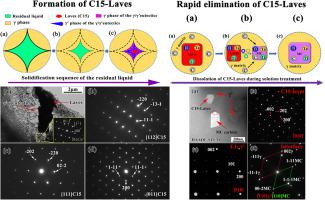Journal of Alloys and Compounds ( IF 5.8 ) Pub Date : 2021-09-20 , DOI: 10.1016/j.jallcom.2021.162016 Yi Zhang 1 , Huadong Fu 1, 2, 3 , Jialin He 1 , Jianxin Xie 1, 2, 3

|
Topologically close-packed (TCP) phases such as μ and Laves phases formed during solidification has an important influence on the mechanical properties of superalloys. Understanding the formation and elimination mechanism of TCP phases is the key to promote the development of superalloys. In this study, C15-Laves phase was first found in a Hf-containing Co-based superalloy, meanwhile, the formation mechanism and thermal stability of the C15-Laves phase were clarified. The results showed that the formation of C15-Laves phase was associated with the segregation behavior of alloying elements during solidification: Co, W and Cr segregated to the dendrite core, and Hf, Ta, Ti, Mo, Ni, Al, Si segregated to the interdendritic region. In the final stage of solidification, the C15-Laves phase enriched in Hf, Ta and Ti formed, and it had similar lattice parameters to the C15-Co2Hf phase. The incipient melting point of C15-Laves phase was between 1170 ℃ and 1180 ℃, and it gradually decomposed to form the Hf-rich MC carbide during solution treatment. The large formation energy differences between the MC carbide and C15-Laves phase promoted a rapid elimination of the C15-Laves phase, which reduced solution treatment time of the alloy. The results can provide a theoretical basis and experimental data support for the composition design and heat treatment process optimization of multicomponent novel Co-based superalloys.
中文翻译:

含Hf钴基高温合金中C15-Laves相的形成机理及热稳定性
在凝固过程中形成的拓扑密堆积 (TCP) 相,例如 μ 和 Laves 相,对高温合金的机械性能有重要影响。了解TCP相的形成和消除机制是推动高温合金发展的关键。本研究首次在含 Hf 的钴基高温合金中发现了 C15-Laves 相,同时阐明了 C15-Laves 相的形成机制和热稳定性。结果表明,C15-Laves 相的形成与合金元素在凝固过程中的偏析行为有关:Co、W 和 Cr 偏析到枝晶核,Hf、Ta、Ti、Mo、Ni、Al、Si 偏析为树突间区域。在凝固的最后阶段,形成了富含 Hf、Ta 和 Ti 的 C15-Laves 相,2 Hf 相。C15-Laves相的初熔点在1170~1180℃之间,在固溶处理过程中逐渐分解形成富Hf的MC碳化物。MC 碳化物和 C15-Laves 相之间的巨大形成能差异促进了 C15-Laves 相的快速消除,从而减少了合金的固溶处理时间。研究结果可为多组分新型钴基高温合金的成分设计和热处理工艺优化提供理论依据和实验数据支持。











































 京公网安备 11010802027423号
京公网安备 11010802027423号